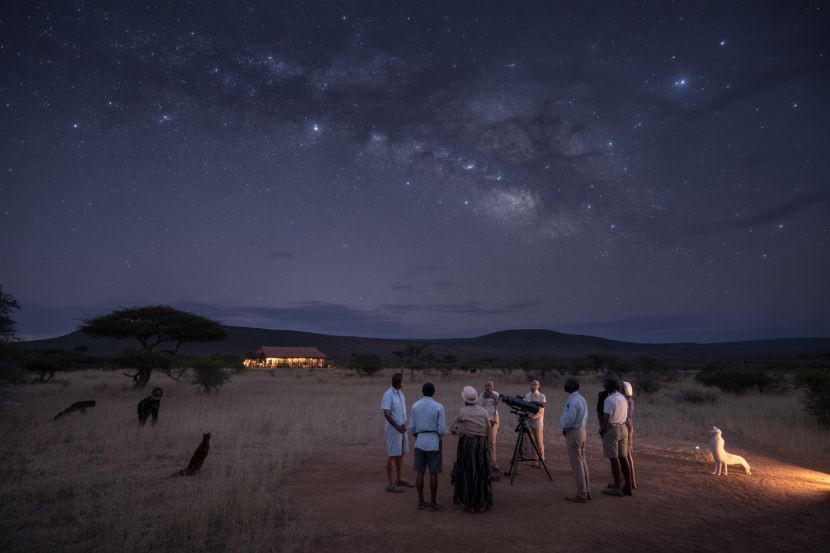Samburu, Kenya: The Leading Destination for Noctourism and Astrotourism in Africa
Samburu, Kenya, leads the way in Africa’s noctourism trend, offering unforgettable stargazing and night safari experiences. Discover more about this new tourism frontier.
Kenya’s Samburu National Reserve has quickly become the focal point for astrotourism in East Africa, offering travelers a chance to experience the night sky in a way few places in the world can. With its exceptionally dark skies and minimal light pollution, the region has rapidly positioned itself as a key destination for nocturnal tourism, or “noctourism,” where travelers can immerse themselves in after-dark experiences that highlight both nature and the cosmos.
As the world increasingly embraces after-dark activities, Kenya has harnessed its natural assets, bringing stargazing, night safaris, and cultural storytelling to the forefront of its tourism offerings. For travelers looking for something more than traditional daytime game drives, Samburu provides an unforgettable experience under the stars, aligning perfectly with Africa’s emerging nocturnal tourism trend.
The Rise of Noctourism in Africa
Noctourism, a concept that refers to the growing trend of after-dark experiences in travel, is rapidly gaining popularity across the globe. Within this trend, astrotourism focuses specifically on exploring the night sky. As more and more travelers seek unique, quiet, and mystical experiences, stargazing and astronomy-related activities are quickly becoming a key component of many tourism itineraries.
The trend is especially strong in regions with clear skies and minimal light pollution—like Samburu, Kenya. Surveys indicate that over half of travelers now consider night-time activities when planning their trips, and East Africa is uniquely positioned to meet this demand with its natural resources, including vast wildernesses and excellent visibility of celestial bodies.
Samburu: Kenya’s Gateway to Astrotourism
In September 2025, Kenya officially launched its astrotourism initiative in Samburu, marking a new chapter in the country’s tourism offerings. The initiative featured a planetarium reveal and guided night sky experiences, with the program timed to coincide with a total lunar eclipse, which attracted widespread attention from regional media and industry outlets.
What sets Samburu apart is not just the beauty of the stars, but the way local culture and modern astronomy intersect. Travelers can enjoy guided stargazing tours with state-of-the-art telescopes, all while learning about the rich indigenous star lore passed down through generations. The combination of science and culture makes Samburu one of the most unique destinations for nocturnal experiences in Africa.
What Noctourism Looks Like in Action
In Samburu, night activities are designed to complement the region’s traditional safari offerings, turning an evening into an extraordinary adventure. The typical itinerary pairs daytime game drives with nocturnal activities such as stargazing, fly-camping, and nocturnal drives, where travelers are guided through the bush at night to see animals like owls, small cats, and other elusive species that are most active after dark.
The real draw during these night safaris is the absence of light pollution. The absence of urban glow enhances the visibility of the night sky, offering visitors an unparalleled opportunity to see both northern and southern constellations. Whether it’s observing the Milky Way, tracking the path of the International Space Station, or witnessing a meteor shower, the experiences on offer in Samburu add an entirely new dimension to Kenya’s wildlife tourism.
Additionally, during new moon periods, visibility is at its best, and the nights are filled with activities like astrophotography, laser-guided constellation tours, and interpretation of the sky through the lens of local culture.
Expanding Beyond Samburu: The Broader Noctourism Push
While Samburu is leading the charge, the noctourism trend is spreading throughout East Africa and beyond. In Tanzania, operators offer star-bed experiences where travelers sleep under the stars in luxurious, open-air beds, while southern Africa has begun promoting astronomy nights in reserves like South Africa’s Kruger National Park and Namibia’s Sossusvlei. The continent’s vast wilderness areas are perfect for astrotourism experiences, thanks to their natural protection from urban light pollution.
This broader regional push for dark-sky tourism is turning parts of Africa into some of the best places for stargazing globally. The growth of these experiences is also helping Africa tap into a unique segment of the global tourism market, attracting travelers looking for a peaceful, awe-inspiring way to experience the continent’s natural beauty.
Economic and Community Impact of Noctourism
Noctourism, including astrotourism, offers considerable benefits for local destinations and communities. For Kenya, the launch of astrotourism in Samburu and other regions creates new revenue opportunities during the cooler evening hours when other tourist activities typically slow down. This helps spread visitor activity across the day, reducing overcrowding during peak daytime hours and increasing the length of stays for visitors.
For local communities, noctourism provides a platform for cultural programming that celebrates indigenous traditions. In Samburu, for example, indigenous star stories are shared alongside scientific facts about the stars, creating a rich cultural experience for visitors. Additionally, low-impact night markets and cultural performances under the stars offer new economic opportunities for local artisans and performers.
What’s Next for Noctourism in Africa
Samburu’s successful launch serves as a model for other African destinations looking to capitalize on noctourism. As Kenya’s Tourism Ministry and regional partners explore new initiatives to protect dark skies and promote safe, sustainable night-time tourism, Samburu remains at the forefront. New programs include telescope-assisted viewing, star dinners, and planetarium-style programming that are beginning to roll out across other regions of East Africa.
To further capitalize on the growing interest, destinations are also focusing on training specialized guides, ensuring safety standards and providing clear conservation guidelines for the growing nocturnal tourism sector.
Quick Tips for Travelers to Experience Noctourism
- Plan Your Visit Around the New Moon: For optimal stargazing, visit during the new moon phase, when the sky is darkest and most visible.
- Pack for the Night: Even in warm destinations like Samburu, evenings can get chilly, so be sure to bring a warm jacket or blanket for nighttime activities.
- Take Advantage of Expert Guides: Participate in laser-guided constellation tours and astrophotography sessions to deepen your understanding of the night sky.
- Book in Advance: As noctourism is becoming increasingly popular, booking early is essential to secure your spot, especially for new moon periods.
Conclusion: A Starry Future for Noctourism in Africa
As Samburu leads the way in Africa’s noctourism revolution, this trend is set to expand across the continent. The combination of Africa’s breathtaking landscapes, rich cultural history, and pristine night skies makes it a perfect destination for stargazing and nocturnal adventures. Whether you’re an avid astronomer or simply looking for a peaceful escape, Africa’s dark skies provide an unforgettable experience that adds a new layer to the continent’s renowned wildlife tourism.
Source:https://katakenya.org/
The post Samburu, Kenya: The Leading Destination for Noctourism and Astrotourism in Africa appeared first on Travel and Tour World


Comments and Responses
Please login. Only community members can comment.